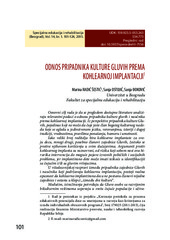Приказ основних података о документу
Attitude of deaf culture toward cochlear implantation
Odnos pripadnika kulture gluvih prema kohlearnoj implantaciji
| dc.creator | Radić-Šestić, Marina | |
| dc.creator | Ostojić, Sanja | |
| dc.creator | Đoković, Sanja | |
| dc.date.accessioned | 2021-06-09T14:08:30Z | |
| dc.date.available | 2021-06-09T14:08:30Z | |
| dc.date.issued | 2015 | |
| dc.identifier.issn | 1452-7367 | |
| dc.identifier.uri | http://rfasper.fasper.bg.ac.rs/handle/123456789/904 | |
| dc.description.abstract | The main aim of this paper is to analyze relevant data on the attitudes of members of the deaf culture and scientists toward cochlear implantation on the basis of available literature. From the perspective of the deaf, an individual who cannot hear is a member of rich cultural background which is characterized by unique language, beliefs, history and other tradition, values, rules of behavior, humor, and art. Although a large number of parents choose cochlear implants for their children, many other people, especially members of the deaf community, strongly oppose their use in all cases. Arguments against cochlear implants are various, from the risks associated with this surgical procedure to the possible psychiatric and social problems, since a child with cochlear implant may have difficulties in identifying with hearing and/or deaf peers. In the several decades long debate between the members of the deaf community and scientists who support cochlear implantation, there is a risk that children with cochlear implants will not become members of either community, and will stay trapped 'between two cultures'. However, studies indicate that deaf people with developed bicultural skills succeed in the hearing world and are supported by the deaf community. Biculturalization indicates that relation to the deaf community is for deaf people equally important means of identification and social support as the relation with the hearing population. | en |
| dc.description.abstract | Osnovni cilj rada je da se pregledom dostupne literature analiziraju relevantni podaci o odnosu pripadnika kulture gluvih i naučnika prema kohlearnoj implantaciji. Iz perspektive pripadnika kulture Gluvih, pojedinac koji ne može da čuje jeste član bogatog kulturnog nasleđa koje se ogleda u jedinstvenom jeziku, verovanjima, istoriji i dugoj tradiciji, vrednostima, pravilima ponašanja, humoru i umetnosti. Iako veliki broj roditelja bira kohlearne implantate za svoju decu, mnogi drugi, posebno članovi zajednice Gluvih, žestoko se protive njihovom korišćenju u svim slučajevima. Argumenti protiv kohlearnog implanta su raznovrsni, od rizika koji sobom nosi ova hirurška intervencija do moguće pojave izvesnih psihičkih i socijalnih problema, jer implantirano dete može imati teškoće u identifikacijii sa čujućim i/ili sa gluvim vršnjacima. U višedecenijskoj raspravi između pripadnika zajednice Gluvih i naučnika koji podržavaju kohlearnu implantaciju, postoji realna opasnost da kohlearno implantirana deca ne postanu članovi nijedne zajednice i ostanu u klopci 'između dve kulture'. Međutim, istraživanja potvrđuju da Gluve osobe sa razvijenim bikulturnim veštinama uspevaju u svetu čujuće populacije i uživaju podršku Gluve zajednice. Bikulturalizacija ukazuje da je Gluvim osobama održavanje veze sa zajednicom Gluvih jednako važan izvor identifikacije i socijalne podrške kao i održavanje veze sa čujućom populacijom. | sr |
| dc.publisher | Univerzitet u Beogradu - Fakultet za specijalnu edukaciju i rehabilitaciju, Beograd | |
| dc.relation | info:eu-repo/grantAgreement/MESTD/Basic Research (BR or ON)/179025/RS// | |
| dc.rights | openAccess | |
| dc.rights.uri | https://creativecommons.org/licenses/by-sa/4.0/ | |
| dc.source | Specijalna edukacija i rehabilitacija | |
| dc.subject | deaf community | en |
| dc.subject | deaf culture | en |
| dc.subject | cochlear implantation | en |
| dc.subject | scientists | en |
| dc.subject | zajednica Gluvih | sr |
| dc.subject | kultura gluvih | sr |
| dc.subject | kohlearna implantacija | sr |
| dc.subject | naučnici | sr |
| dc.title | Attitude of deaf culture toward cochlear implantation | en |
| dc.title | Odnos pripadnika kulture gluvih prema kohlearnoj implantaciji | sr |
| dc.type | article | |
| dc.rights.license | BY-SA | |
| dc.citation.epage | 124 | |
| dc.citation.issue | 1 | |
| dc.citation.other | 14(1): 101-124 | |
| dc.citation.rank | M51 | |
| dc.citation.spage | 101 | |
| dc.citation.volume | 14 | |
| dc.identifier.doi | 10.5937/specedreh1-7156 | |
| dc.identifier.fulltext | http://rfasper.fasper.bg.ac.rs/bitstream/id/784/901.pdf | |
| dc.type.version | publishedVersion |


